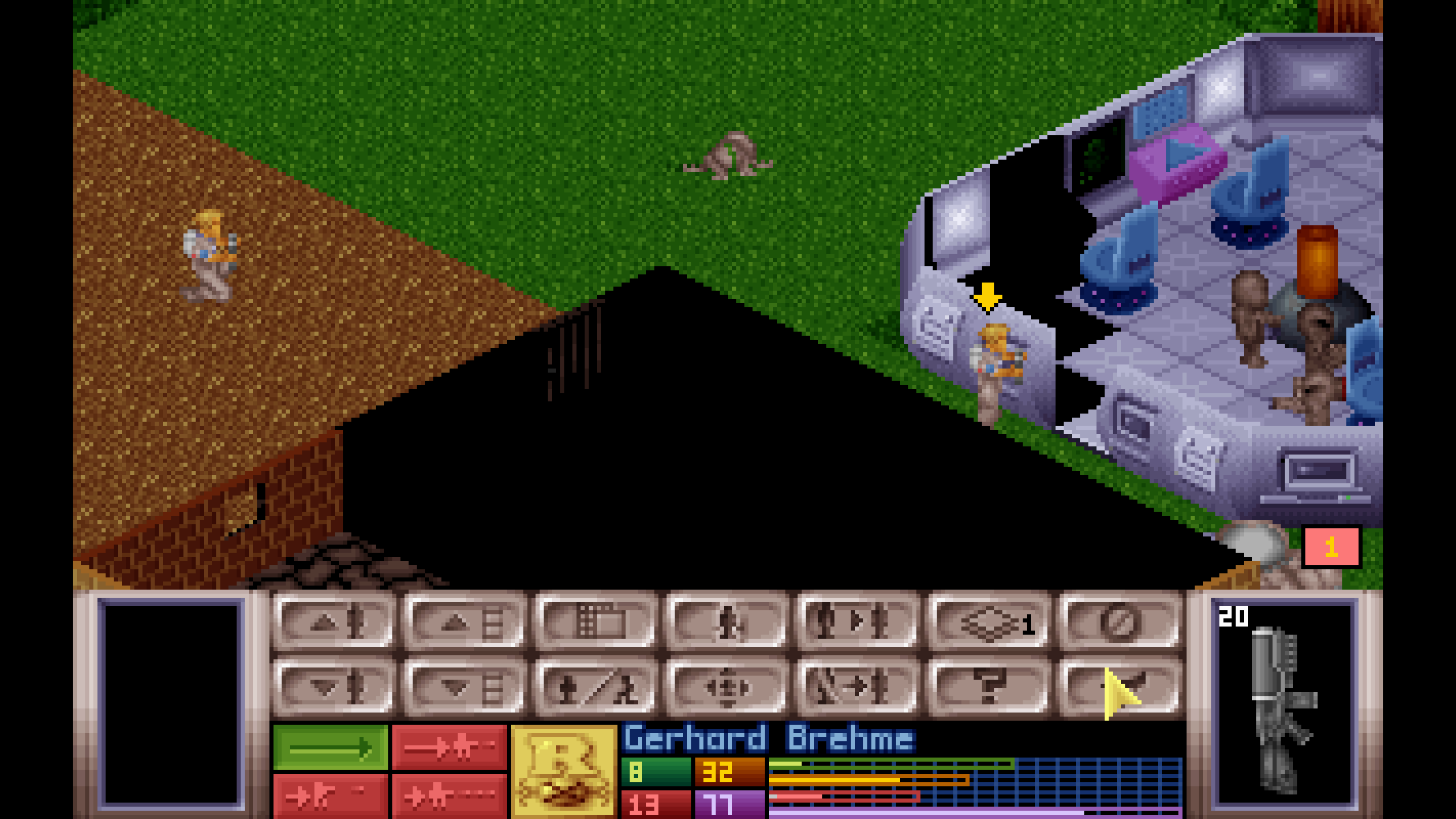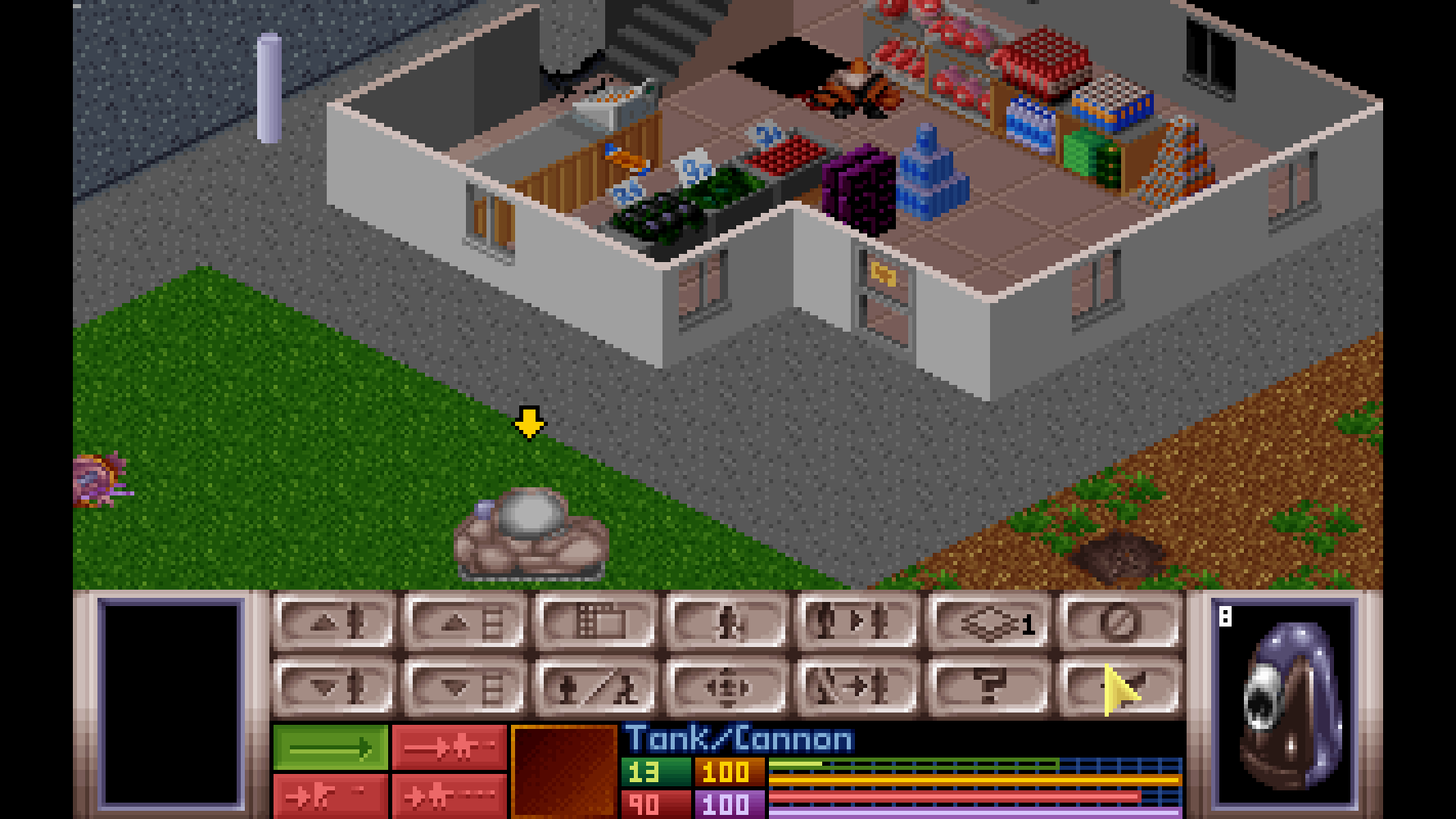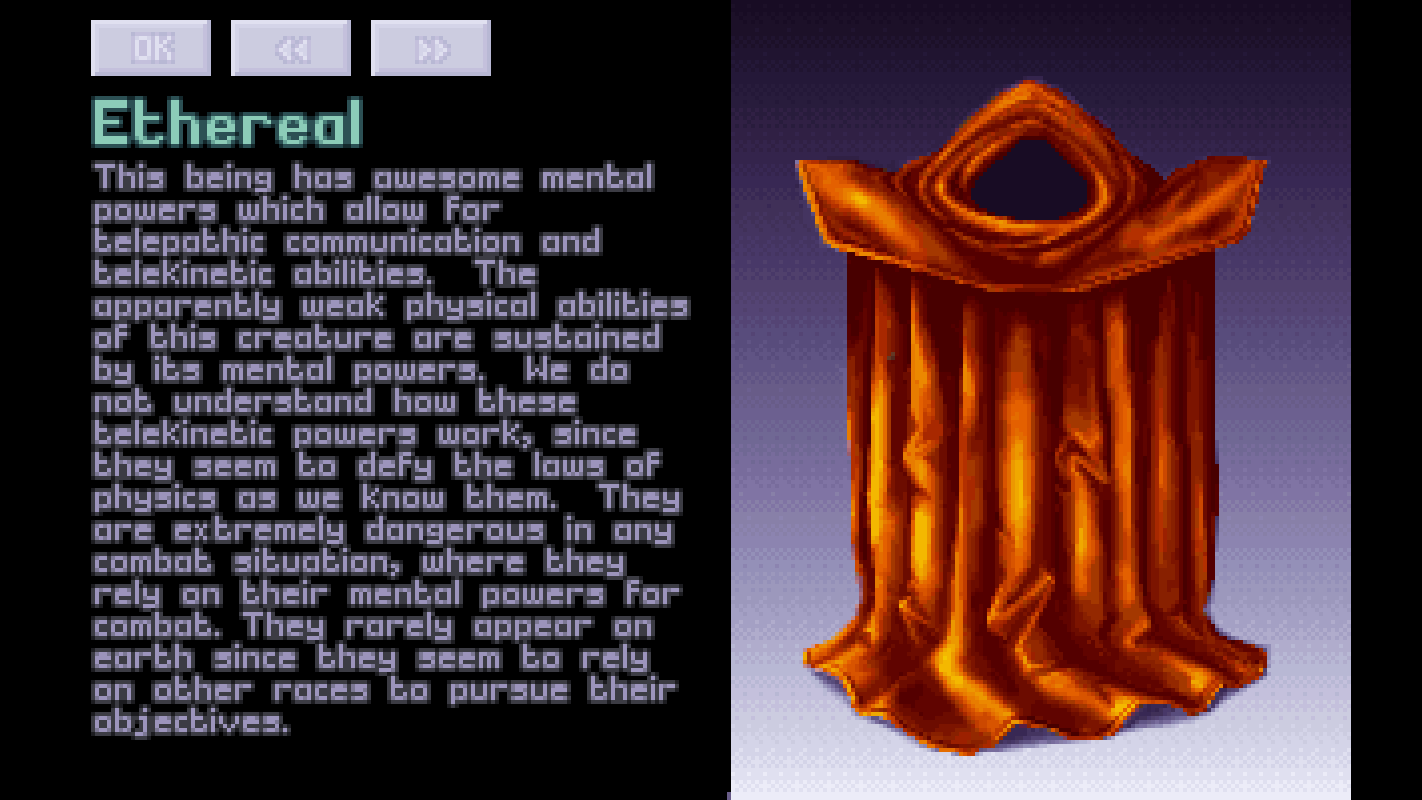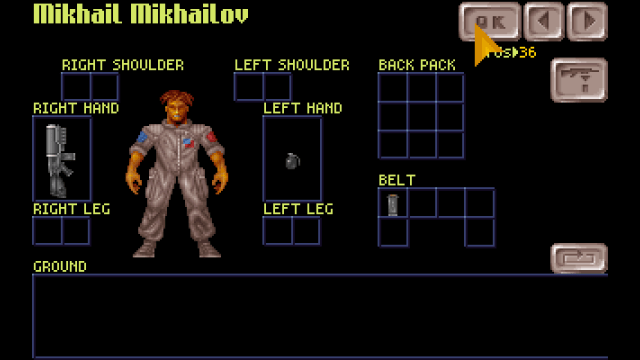Monsters in the Dark: The Making of X-COM: UFO Defence tells the story of the early years of legendary strategy game designer Julian Gollop and the making of the original X-COM, and is funding now on Kickstarter. In this excerpt from the book, Julian and designers from publisher MicroProse UK reveal how the atmosphere of the game (known as UFO: Enemy Unknown in the UK) added even more tension to the blink-and-you’re-dead tactical gameplay.
UFO: Enemy Unknown’s abstract Geoscape view helped players feel insulated from the alien threat. X-COM commanders floated above the world making decisions about research and construction, emotionally and physically detached from the goings-on far below. Inevitably, a UFO appeared on their radar, and they had to shoot it down (known as intercepting in the game’s lexicon) and dispatch a squad of X-COM’s finest to get their hands dirty.
Interception bridged the gap between the Geoscape and Battlescape interfaces. It was also the opening salvo to every battle, and one that X-COM lead designer and programmer Julian Gollop implemented, gutted, and re-designed several times. “Lords of Chaos gave the player a lot of options without much guidance. What I felt about X-COM was it needed to pay attention to certain details, of which there were quite a few in the game, and all the elements of the game had to fit together as a relatively seamless whole.”
Early on, interception played like a mini-game. From a first-person view, players zoomed through clouds until UFOs broke through. Then they tapped keys to fire their aircraft’s primary and secondary weapons, all purchased, built, and outfitted in Geoscape mode. Through the viewport, they watched as their rockets cut through clouds and connected with UFOs, or did not. MicroProse UK’s designers sent feedback to Julian and [co-programmer] Nick Gollop that the mode wasn’t visually convincing enough. “If we’d had more time and investment on the programming side, we could have made that work,” Julian explains.
Julian reworked the presentation, but the general thrust — chase down a UFO and fire when ready — remained intact. Visually, interception became more analytic and representative, which gelled with the rest of Geoscape’s milieu. In terms of design, it made more sense than a shooter-esque mini-game. “It was only me and Nick working on programming and design, and we had to be efficient, so we had to think carefully about what we put into the game and what we excluded. Anything that was in there had to have a reason to be in there.”
Once intercepted, UFOs plummeted to earth, where a change in perspective awaited players and their X-COM squad. On the ground, they got an isometric view of their shuttle and the soldiers tucked inside it. Soldiers had to be deployed one by one, and each squad member’s time units determined what they could do, how far they could move, and so forth. “I called them action points, but they got changed to time units, which wasn’t my decision,” Julian recalls.
The decision to rename action points came from a designer at MicroProse UK. Julian argued that time unit didn’t make sense: Each turn consumed the same amount of time, but the actions available to soldiers might differ by cost. MicroProse UK insisted, so Mythos Games made the change. The gist of fundamentals remained: More time units equaled more options. Julian’s primary goal was to saddle players with big decisions right away. The first, which set the tone of a mission and toyed with players’ mental state, was: Which soldier should set foot out of the vehicle first?
Soldiers hauled around more than weapon, ammos, and names. Each had a rank that increased over the course of the game. Rank wasn’t synonymous with character levels in a role-playing game: A soldier of a higher rank didn’t shoot more accurately or deal more damage. Instead, they exerted greater influence over lower-ranked soldiers, a characteristic arguably more important than accuracy or damage. Soldiers who panicked and tried to flee became easy targets. For that reason, MicroProse UK’s designers got into the habit of deploying low-ranking soldiers first as scouts.
“I have no idea how many of my gallant troopers were shot, shredded, killed by stupid grenade throws, and reduced to heaps of pixels thanks to my efforts,” says MicroProse UK designer Mike Brunton. “At one point, whoever was first off the aircraft at a UFO crash site should have been zipping themselves into a body bag before leaving the vehicle. I got used to micromanaging the initial turn just so that the rookies would take the bullet, not my squad leaders.”

It’s a testament to the connection players formed with their squads that they might hesitate to order even the greenest rookie out of the shuttle. Several factors compounded their reluctance. First was composer John Broomhall’s terrifying soundtrack. In the Geoscape, Broomhall’s music is low and gloomy, as if reminding players they could only cower in the relative safety of base management for so long; eventually, they had to board a ship and get their hands dirty. Battlescape’s soundscape was more unnerving. Less a piece of music than an ambient piece with an undercurrent of rhythm, the soundtrack comprised pulsing rumbles, ebbing and flowing until players felt it in their pulse. That ceaseless growling and rumbling produced a sound almost unlike any a human could make, as if the aliens sought to disrupt players’ ability to think clearly as terror settled deeper into their bones.
“Compositionally, the pulsing was a device to set up tension and a kind of dread and inevitability,” Broomhall says of the Battlescape track. “I thought it might be good to very subtly change the tempo up and down a couple of beats per minute here and there so that just when your brain had locked on to the repeating pattern and its regularity, it was subliminally disrupted. It turned out this was very unsettling.”
The second factor that gave players pause was the game’s lighting. After Nick implemented a timer in Geoscape mode, Julian proposed missions that could take place at night. In daylight, the sun bathed the terrain in light, a change as functional as it was stylish, since it let soldiers see further ahead. At night, more pixels darkened, cloaking all but the closest terrain in blackness. “It was about the atmosphere of the game,” Julian says. “I wanted to hit on something close to the ‘something hidden in the darkness’ feeling that you got from watching the Alien films, which were a big influence on me. Originally, they were all going to be night missions.”
Nick and Julian devised a simple but effective algorithm for Enemy Unknown’s lighting system. Lighting was based on soldiers rather than line of sight. Light emanated from each character, so assuming they stood apart from other objects with light sources, such as their comrades, adjacent pixels in all directions turned a shade darker. The pixels near those darkened another shade, then another and so on, each pixel’s light value decreasing in a smooth gradient until blackness swallowed visibility.

The most discomforting aspect of Enemy Unknown’s lighting was that aliens could be seen moving on the outskirts of visibility, like poisonous insects creeping just out of sight. Players could fire wild shoots into the darkness, but their odds of hitting a target were low. They had to see an alien to kill or apprehend it. “You could throw light flares to light up areas,” says Julian, “so we gave you the feeling that you were restricted, and that there were monsters lurking in the dark.”
Unfortunately for players, the aliens did not operate under the same restriction. They saw perfectly in any condition, calling for players to either approach them — preferably with multiple soldiers to light up as much of their surroundings as possible — or throw light flares to reveal aliens from afar. However, just because aliens boasted night vision didn’t mean they knew where to find their prey. “The AI was an evolution from Laser Squad and Lords of Chaos as well,” Julian says. “Obviously, a big part of the game being replayable was making sure the AI was strong without cheating.”
Julian and Nick wrote AI routines to simulate the guesswork inherent in tracking unseen targets. For instance, after a soldier disappeared from an alien’s line of sight, their AI informed it where to find that soldier for another turn or two, a way to simulate making an educated guess at where the soldier might have gone. “After that, they wouldn’t know where you were. They would have to seek opportunities to surprise you from behind,” Julian adds.
While players decided how best to move their squad, the aliens shared certain movement routines. All aliens followed patrol routes until they spotted players. From there, unique AI algorithms kicked in depending on each alien’s type and weaponry. Snakemen moved in for the kill, while aliens equipped with firepower drew only as close as was necessary to increase their accuracy. Players’ best bet for Battlescape missions was to group characters into a formation and scout the map.
Discovering an alien triggered one of several outcomes. The alien broke patrol and retreated to an area where its peers lay in wait, or it went on the offensive. If the alien kept its distance, players were wise to select soldiers with ranged weapons to apply pressure. Heavy-hitting weapons worked best at close range. In reality, there was no optimal plan. Procedurally generated terrain, the types and configurations of aliens on a map, their AI routines, and other issues mounted against players, forcing them to think on the fly.

“The only way you could balance the game perfectly would be to remove some choices for the player to make,” Julian says. “A lot of games today are very structured experiences, and I find that disconcerting, because I feel a bit manipulated. The attempt with X-COM was to say to the player, ‘Look, there’s no one best strategy for the game, so go ahead and experiment.’”
Experimenting was more a requirement than a strong suggestion. Enemy Unknown incorporated a dynamic difficulty to make the aliens adaptable to smart players. “I put it in because we faced this almost-impossible QA challenge,” says Julian. “I created a game system that was relatively complex. To play from beginning to end, to explore all the different possibilities and strategies, would take forever.”
As Enemy Unknown went on, players captured aliens and learned new technology that brought their firepower more in line with that of the invaders. Of course, the aliens evolved, too. That led Julian to code dynamic difficulty out of necessity. In the final months of development, MicroProse UK had only four quality assurance (QA) testers to put the game through its paces, nowhere near enough to uncover most bugs, glitches, and strategies. A dynamic difficulty system assured a consistent challenge to players of any skill level and play style.
“If players did poorly in, say, the previous three tactical missions, I would slow down the rate of alien advance,” says Julian. “If players did very well — say, if they got good scores on tactical missions several times in a row — the aliens ramped up their technological development.” As aliens evolved, they brought new ships, weapons, and units into battle. “The idea was to keep the level of challenge for the player reasonably consistent because one of the problems with a game is, if it’s too easy or too difficult, it becomes uninteresting,” Julian adds.
Other variables influenced difficulty. Procedural generation could generate a map smaller or larger than others, or one with little cover, or much in the way of visual variety, which meant fewer tactical options. “I didn’t actually have much time to do lots of level design,” Julian admits. “Once we got the game systems working, most level design was done very near the end of the project. If we’d had a bit more funding, I would have hired someone to work on the level design specifically, so they could really focus on developing that and improving that.”
@davidlcraddock on Twitter. Monsters in the Dark: The Making of X-COM: UFO Defence is funding now on Kickstarter.

Leave a Reply